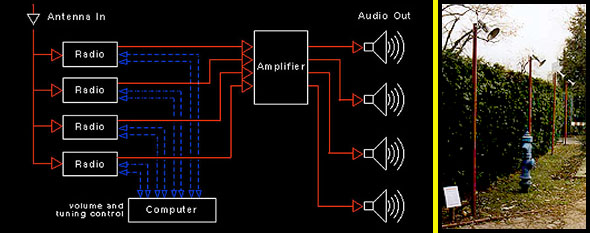RADIATION
An Installation for Short Wave Radio
by Robert Adrian and Norbert Math

The signals from four short wave radio receivers, each tuned to a different source, are fed into an amplifier and distributed to four loudspeakers installed about 400 cm apart and 350 cm high. A computer program controls the receivers so that they are always tuned to active and interesting short wave channels.

|
In the second year of the 20th century the signals from Guglielmo Marconi's first trans-Atlantic radio transmission began their journey across the Solar System. Since then radio waves have become as common as air and our planet has become a new source of radio waves in the galaxy. All the radio signals ever produced since Marconi's experiment are still radiating outwards through space. The history of our century exists at the speed of light in the dark spaces between the worlds.
Marconi's radio used long wavelenths requiring very large antennas for transmission and reception. This remained the case for about 20 years - untill the technicians trained for the first world war returned home and began to experiment with short wave technology. It was discovered that short wave signals could be transmitted thousands of miles by bouncng them off the ionosphere. By the mid-thirties all the major countries were employing short wave radio for military and diplomatic communication. During the second world war radio technology became more sophisticated in reponse to the need for communication with armies and navies spread out across the world as well as the rapid deployment and control of air forces and for subversive information warfare involving encryption, deception and propaganda.
The "RADIATION" project concentrates on short wave radio - the wave-lengths used mostly by security/espionage agencies, national propaganda/information stations and by amateur radio operators. Many short wave transmissions are received as bursts of coded or scrambled signal - morse, fax or image transmissions and secret commercial or political data. The short wave spectrum contains every human language and every kind of music. Short wave signals are often distorted by atmospheric conditions, bursts of electro-magnetic activity on the Sun, interference from other transmitters or local static - with short wave radio it is "radio" itself that is in the foreground.

1998: original installation at the Ars Electronica Festival 98, Linz.
2002: installed at "Broadcasting", Technical Museum, Zagreb.
2004: installed at "Reinventing Radio", Radiokulturhaus, Vienna.
2006: installed at "Waves", Latvian National Museum of Art, Riga.
2008: installed at "Waves", HMKV, Phoenixhalle, Dortmund.
2008: installed at "ZeitRaumZeit", Künstlerhaus, Vienna

|
|